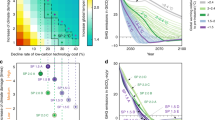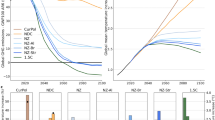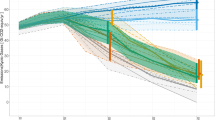Abstract
Benchmarks to guide countries in ratcheting-up ambition, climate finance, and support in an equitable manner are critical but not yet determined in the context of the Paris Agreement1. We identify global cost-optimal mitigation scenarios consistent with the Paris Agreement goals and allocate their emissions dynamically to countries according to five equity approaches. At the national level, China's Nationally Determined Contribution (NDC) is weaker than any of the five equity approaches, India's and the USA's NDC are aligned with two, and the EU's with three. Most developing countries’ conditional (Intended) NDCs (INDCs) are more ambitious than the average of the five equity approaches under the 2 °C goal. If the G8 and China adopt the average of the five approaches, the gap between conditional INDCs and 2 °C-consistent pathways could be closed. For an equitable, cost-optimal achievement of the 1.5 °C target, emissions in 2030 are 21% lower (relative to 2010) than for 2 °C for the G8 and China combined, and 39% lower for remaining countries. Equitably limiting warming to 1.5 °C rather than 2 °C requires that individual countries achieve mitigation milestones, such as peaking or reaching net-zero emissions, around a decade earlier.
This is a preview of subscription content, access via your institution
Access options
Subscribe to this journal
Receive 12 print issues and online access
$209.00 per year
only $17.42 per issue
Buy this article
- Purchase on Springer Link
- Instant access to full article PDF
Prices may be subject to local taxes which are calculated during checkout



Similar content being viewed by others
Change history
01 February 2017
In Fig. 1c of the original version of this Letter, the 2030 assessment of the NDC for the USA was misplotted. This changed the number of equity approaches that the USA's NDC was in line with. The figure and text that referred to the findings of that figure have been updated.
References
Adoption of the Paris Agreement FCCC/CP/2015/L.9/Rev.1 (UNFCCC, 2015); http://unfccc.int/resource/docs/2015/cop21/eng/l09r01.pdf
Synthesis Report on the Aggregate Effect of the Intended Nationally Determined Contributions FCCC/CP (UNFCCC, 2015).
Meinshausen, M. & Alexander, R. INDC Factsheets. Australian-German Climate and Energy College (2015); http://climatecollege.unimelb.edu.au/indc-factsheets
Rogelj, J. et al. Paris Agreement climate proposals need a boost to keep warming well below 2 °C. Nature 534, 631–639 (2016).
United Nations Framework Convention on Climate Change FCCC/INFORMAL/84 (UNFCCC, 1992); https://unfccc.int/resource/docs/convkp/conveng.pdf
Averchenkova, A., Stern, N. & Zenghelis, D. Taming the Beasts of ‘Burden-Sharing’: An Analysis of Equitable Mitigation Actions and Approaches to 2030 Mitigation Pledges (Centre for Climate Change Economics and Policy, Grantham Research Institute on Climate Change and the Environment, 2014).
Mace, M. J. Mitigation commitments under the Paris Agreement and the way forward. Clim. Law 6, 21–39 (2016).
Voigt, C. & Ferreira, F. Differentiation in the Paris Agreement. Clim. Law 6, 58–74 (2016).
Impact Assessment: Document Accompanying the Package of Implementation Measures for the EU’s Objectives on Climate Change and Renewable Energy for 2020 Proposals (Commission of the European Communities, 2008).
Information, Views and Proposals on Matters Related to the Work of Ad Hoc Working Group on the Durban Platform for Enhanced Action (ADP) Workstream 1 (Submission by Japan, 2014).
Nepal on Behalf of the Least Developed Countries Group Views and Proposals on the Work of the Ad Hoc Working Group on the Durban Platform for Enhanced Action (ADP) (2014).
BASIC experts, Equitable Access to Sustainable Development: Contribution to the Body of Scientific Knowledge (BASIC Expert Group, 2011).
Submitted INDCs (UNFCCC, accessed 5 February 2016); http://www4.unfccc.int/submissions/indc
Baer, P., Fieldman, G., Athanasiou, T. & Kartha, S. Greenhouse Development Rights: towards an equitable framework for global climate policy. Camb. Rev. Int. Aff. 21, 649–669 (2008).
den Elzen, M., Höhne, N. & Moltmann, S. The Triptych approach revisited: a staged sectoral approach for climate mitigation. Energy Policy 36, 1107–1124 (2008).
Jacoby, H. D., Babiker, M. H., Paltsev, S. & Reilly, J. M. Sharing the Burden of GHG Reductions (MIT, 2008).
Nabel, J. E. M. S. et al. Decision support for international climate policy - The PRIMAP emission module. Environ. Model. Softw. 26, 1419–1433 (2011).
Höhne, N., den Elzen, M. & Escalante, D. Regional GHG reduction targets based on effort sharing: a comparison of studies. Clim. Policy 14, 122–147 (2013).
Tavoni, M. et al. Post-2020 climate agreements in the major economies assessed in the light of global models. Nat. Clim. Change 5, 119–126 (2014).
Raupach, M. R. et al. Sharing a quota on cumulative carbon emissions. Nat. Clim. Change 4, 873–879 (2014).
Pan, X., Teng, F., Tian, Y. & Wang, G. Countries’ emission allowances towards the low-carbon world: a consistent study. Appl. Energy 155, 218–228 (2015).
Meinshausen, M. et al. National post-2020 greenhouse gas targets and diversity-aware leadership. Nat. Clim. Change 5, 1098–1106 (2015).
Peters, G. P., Andrew, R. M., Solomon, S. & Friedlingstein, P. Measuring a fair and ambitious climate agreement using cumulative emissions. Environ. Res. Lett. 10, 105004 (2015).
Robiou du Pont, Y., Jeffery, M. L., Gütschow, J., Christoff, P. & Meinshausen, M. National contributions for decarbonizing the world economy in line with the G7 agreement. Environ. Res. Lett. 11, 054005 (2016).
Clarke, L. et al. in Climate Change 2014: Mitigation of Climate Change (eds Edenhofer, O. et al.) 456–462 (IPCC, Cambridge Univ. Press, 2014).
Rogelj, J. et al. Energy system transformations for limiting end-of-century warming to below 1.5 °C. Nat. Clim. Change 5, 519–527 (2015).
Caney, S. Justice and the distribution of greenhouse gas emissions. J. Glob. Ethics 5, 125–146 (2009).
Geden, O. An actionable climate target. Nat. Geosci. 9, 340–342 (2016).
Schleussner, C.-F. et al. Differential climate impacts for policy-relevant limits to global warming: the case of 1.5 °C and 2 °C. Earth Syst. Dyn. Discuss. 6, 2447–2505 (2016).
Meinshausen, M., Raper, S. C. B. & Wigley, T. M. L. Emulating coupled atmosphere-ocean and carbon cycle models with a simpler model, MAGICC6 – Part 1: Model description and calibration. Atmos. Chem. Phys. 11, 1417–1456 (2011).
Meinshausen, M., Wigley, T. M. L. & Raper, S. C. B. Emulating atmosphere-ocean and carbon cycle models with a simpler model, MAGICC6 - Part 2: Applications. Atmos. Chem. Phys. 11, 1457–1471 (2011).
Meinshausen, M. et al. Greenhouse-gas emission targets for limiting global warming to 2 °C. Nature 458, 1158–1162 (2009).
Harmsen, M. et al. How well do integrated assessment models represent non-CO2 radiative forcing? Climatic Change 565–582 (2015).
Bernie, D. & Lowe, J. Analysis of Climate Projections from the IPCC Working Group 3 Scenario Database (AVOID2, 2014).
Rogelj, J. et al. Air-pollution emission ranges consistent with the representative concentration pathways. Nat. Clim. Change 4, 446–450 (2014).
The Emission Gap Report 2015 A UNEP Synthesis Report (UNEP, 2015).
Meinshausen, M. et al. The RCP greenhouse gas concentrations and their extensions from 1765 to 2300. Climatic Change 109, 213–241 (2011).
Owen, B., Lee, D. S. & Lim, L. Flying into the future: aviation emissions scenarios to 2050. Environ. Sci. Technol. 44, 2255–2260 (2010).
IPCC Climate Change 2007: The Physical Science Basis (eds Solomon, S. et al.) (Cambridge Univ. Press, 2007).
Cames, M., Graichen, J., Siemons, A. & Cook, V. Emission Reduction Targets for International Aviation and Shipping (European Parliament - Policy Department, 2015).
Anderson, K. & Bows, A. Executing a Scharnow turn: reconciling shipping emissions with international commitments on climate change. Carbon Manag. 3, 615–628 (2012).
Samir, K. C. & Lutz, W. The human core of the shared socioeconomic pathways: population scenarios by age, sex and level of education for all countries to 2100. Glob. Environ. Change http://dx.doi.org/10.1016/j.gloenvcha.2014.06.004 (2014).
Crespo Cuaresma, J. Income projections for climate change research: a framework based on human capital dynamics. Glob. Environ. Change http://dx.doi.org/10.1016/j.gloenvcha.2015.02.012 (2015).
Acknowledgements
We gratefully acknowledge the work of modellers behind the IPCC-AR5 emissions scenarios. M. Meinshausen is supported by the Australian Research Council (ARC) Future Fellowship (grant number FT130100809). Deep thanks to A. Talberg for her comments on the manuscript.
Author information
Authors and Affiliations
Contributions
All authors contributed to discussing the results and writing the manuscript. Y.R.d.P. led the study and performed the calculations. M.L.J. modelled the GDR approach. J.G. downscaled to the national-level global RCP8.5 emissions scenarios using SSP data. Y.R.d.P. and M.M. suggested the study. J.G., M.L.J. and M.M. updated and managed the composite PRIMAP database.
Corresponding author
Ethics declarations
Competing interests
The authors declare no competing financial interests.
Supplementary information
Supplementary Information
Supplementary Information (PDF 2420 kb)
Supplementary Information
Supplementary Information (XLSX 121 kb)
Supplementary Information
Supplementary Information (XLSX 119 kb)
Rights and permissions
About this article
Cite this article
Robiou du Pont, Y., Jeffery, M., Gütschow, J. et al. Equitable mitigation to achieve the Paris Agreement goals. Nature Clim Change 7, 38–43 (2017). https://doi.org/10.1038/nclimate3186
Received:
Accepted:
Published:
Issue Date:
DOI: https://doi.org/10.1038/nclimate3186
This article is cited by
-
Justice considerations in climate research
Nature Climate Change (2024)
-
Comparing the ambition of EU companies with science-based targets to EU regulation-imposed reductions
npj Climate Action (2024)
-
Achieving the 1.5 °C goal with equitable mitigation in Latin American countries
Mitigation and Adaptation Strategies for Global Change (2024)
-
The nexus among CO2 emission, health expenditure and economic development in the OECD countries: New insights from a cross-sectional ARDL model
Environmental Science and Pollution Research (2024)
-
Effective climate clubs require ambition, leverage and insulation: Theorizing issue linkage in climate change and trade
The Review of International Organizations (2024)



